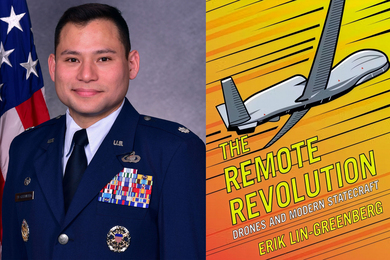Two MIT-trained astronauts walked in space last week during the space shuttle Columbia's high-profile mission to service the Hubble Space Telescope.
The mission significantly improved the capabilities of the telescope, which is used by MIT researchers, by replacing instruments with upgraded varieties.
John M. Grunsfeld (S.B. in physics 1980), Michael J. Massimino (S.M. 1988, M.E., Ph.D.) and two other astronauts on the mission took turns participating in each of five extravehicular activities, or EVAs for short.
During the first two EVAs, the astronauts successfully replaced the solar arrays on Hubble with new gallium arsenide solar arrays, which are smaller but generate 20 percent more power. During the third EVA, the astronauts replaced Hubble's power control unit. This was the riskiest and most difficult EVA of the mission; it involved powering down the telescope during the repair work.
On the fourth EVA, the astronauts installed an Advanced Camera for Surveys (ACS), which operates in the ultraviolet and visible light range and which has twice the resolution and five times the sensitivity of the instrument it replaced. With a larger field of view and improved light collection efficiency, the ACS is expected to improve Hubble's capability for scientific discovery by a factor of 10.
On the fifth EVA, the crew added a cryo cooler and thermal radiator to cool the Near-Infrared Camera and Multi-Object Spectrometer (NICMOS) to around 75 degrees above absolute zero. The NICMOS instrument on Hubble had been inoperative for two years because of a problem with the coolant technology.
"Up here on Columbia, we've just finished five days of space walking," said Grunsfeld from space. "We've given Hubble a new power system that will take it into the next decade of discovery. We've given it new eyes to see deeper into the universe than it's ever been able to see before. And I think you'll see that people at the Space Telescope Science Institute, universities all around the world, and amateur astronomers young and old will be able to enjoy the beauty and inspiration that these new pictures from Hubble will bring."
This isn't Grunsfeld's first Hubble service mission. He has performed two previous space walks to service the Hubble Space Telescope (see MIT Tech Talk, January 12, 2000). He now has more than 37 hours of EVA experience, the third highest in the NASA astronaut corps.
Former NASA astronaut Jeffrey A. Hoffman, who recently returned to MIT as a senior lecturer in the Department of Aeronautics and Astronautics, remembers supervising Grunsfeld's undergraduate work. "I supervised John Grunsfeld when he was a UROP student working on the SAS-3 satellite at MIT's Center for Space Research," Hoffman said. "John said that when I was selected as an astronaut in 1978, it inspired him to want to do the same thing."
Hoffman met with the Hubble servicing crew on a recent trip to Johnson Space Center in Houston to advise them on what to expect during the EVAs.
"The critical thing is not to get complacent," Hoffman said. "The reason we're successful is that there is constant vigilance and attention to detail. We've done extensive testing and the project has provided the tools that are necessary to do the job. The results are evident. It's been spectacularly successful."
Thomas B. Sheridan, Professor of Engineering and Applied Psychology Emeritus, supervised Massimino's Ph.D. thesis research in the Human-Machine Systems Laboratory. "I'm very proud of Mike," said Sheridan. "He had his heart set on becoming an astronaut from the day he set foot in my lab. He was always well-organized and an extremely hard worker. For his Ph.D. thesis research, he worked on human control of telemanipulators, devices similar to what he used in space to repair Hubble. So we can also say that human-robot cooperation in reliable mechanical assembly is something he has been thinking about for years."
MIT alumni have participated in some of the most challenging EVAs in the history of the space program. Buzz Aldrin (Sc.D. 1963) was the first astronaut to train for space walks under water, using neutral buoyancy to simulate weightlessness. His space walks on Gemini 12 in 1966 were widely regarded as the first successful demonstration that humans could work in space.
MIT graduates also participated in the first EVA of the Apollo program aboard Apollo 9, and the first lunar surface EVA on Apollo 11 in 1969. During the Apollo lunar landing missions, four MIT alumni made a total of 10 EVAs, exploring the lunar surface for more than 51 hours.
Several other MIT alumni also played key supporting roles in the recent Hubble servicing mission. Rodger E. Doxsey (S.B. 1969, Ph.D.) is head of the Hubble Division at the Space Telescope Science Institute in Baltimore, Md. and Professor Rodger I. Thompson (S.B. 1966, Ph.D.), of the University of Arizona, is principal investigator for Hubble's NICMOS instrument.
A version of this article appeared in MIT Tech Talk on March 13, 2002.








